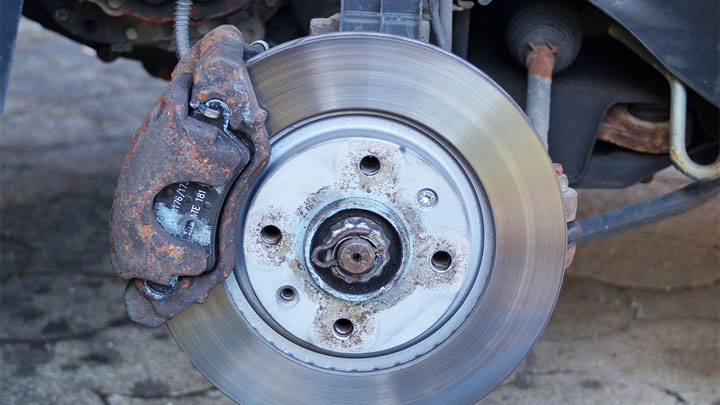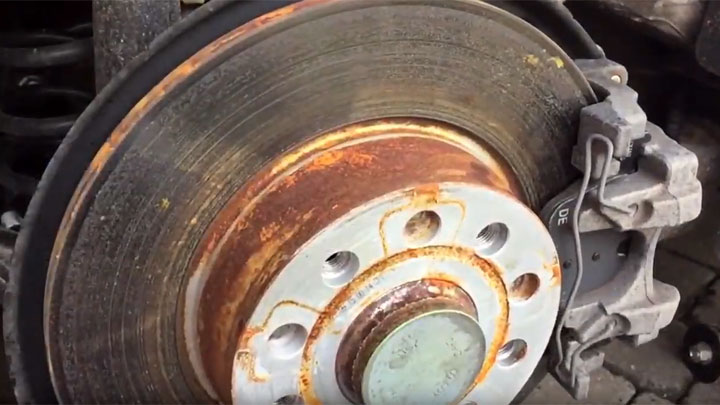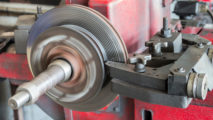Last Updated on April 8, 2022
Any good braking system must have good brake pads. When you drive your car and step on the brake pedal, the brake pads get pressed onto the disc rotors and create friction.
This friction is what causes your vehicle to slow down until it comes to a complete stop, depending on how long you keep your foot on the brake pedal.
Since the brake pads are being used each time you use the brake pedal, they get worn out after several years (or sooner). How long brake pads last depend on the brake pad material, type of vehicle, and how you drive.
Measuring the thickness of brake pad material on a regular basis and replacing worn brake pads before it’s too late is the only thing you can do.
Top 5 Bad Brake Pad Symptoms
To know if your brake pads are going bad, there are certain signs that you can watch out for. A lot of the early symptoms of bad brake pads are not too serious, so you won’t be in immediate danger if you notice them.
But it should motivate you enough to make an appointment with your mechanic, brake shop, or dealership and get the brake pads replaced as soon as possible.
On the other hand, if you have some mechanical knowledge and have done tasks like changing engine oil or replacing your spark plugs, then you should have no problem replacing brake pads on your own. This can save you a good amount of money versus paying a professional to do it for you.
Related: Ceramic vs Organic Brake Pads
Below are the 5 most common symptoms of bad brake pads:
#1 – Noisy Brakes

If you step on the brake pedal and you hear squealing sounds, this could definitely mean that you have bad brake pads. When brake pads get worn out with age, they build up a lot of dust in them. As the dust continues to accumulate in the brake pads, they will start to squeal each time you use the brake.
Not only that, but the brake pads will get so worn down that the brake sensor will touch the disc brake rotor. If the pads are still not replaced by this point, they will continue to get worn down until the backing plate of the brake pad is connecting with the rotor.
Not only does this create scraping noises when you step on the brakes, but your rotor is being gouged and damaged and will need to also be replaced.
#2 – Brake Warning Light

When you have faulty brake pads, one of the easiest symptoms to recognize is when the brake warning light illuminates on the dashboard. This doesn’t always mean the brake pads are at fault, but it lets you know that something is wrong with your braking system.
In any event, this should be a big enough reason to take your vehicle to a mechanic and have them confirm that you need new brake pads.
#3 – Spongy Brake Pedal

If you step on the brake pedal and it feels hard or squishy like a sponge, then you may have worn out brake pads. You will still be able to apply the brakes, but you’ll have to put more pressure on the brake pedal than normal.
Sometimes you might forget this in the event that you have to apply the brakes suddenly. While a spongy brake pedal could indicate bad brake pads, it’s more likely to be a faulty brake master cylinder or brake fluid leak. But in any case, the components in your brake system need to be checked out.
#4 – Slower Brakes

Brake pads that are extremely worn out won’t be able to apply enough friction to the rotors to slow down the vehicle quickly. In other words, the brake response will be very slow each time you step on the brake pedal.
This could cause a serious accident if you’re trying to brake quickly and have to wait for the braking system to catch up because of the bad brake pads.
#5 – Vibrations

When you put your foot on the brake pedal, does it feel like it’s vibrating or pulsating? This could either be due to bad brake pads or bad brake rotors because the vibration occurs when the brake pad makes contact with the rotor.
If one of them is worn or damaged, then it will cause this feeling to occur in the pedal.




